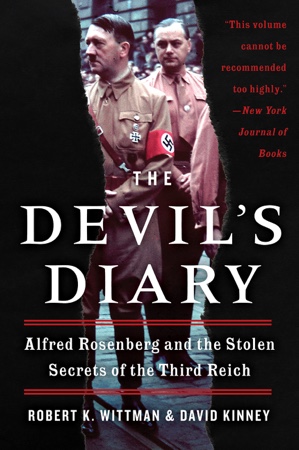The Nazi Diary that Took 12 Years to Track Down and Be Published
Fifteen years ago, the phone rang in my office in Philadelphia, where I led a small team of FBI agents investigating international art crime.
On the line was the chief archivist of the U.S. Holocaust museum, Henry Mayer, and he told me a guy was trying to sell him a one-of-a-kind Nazi diary.
What did he think it was worth, the guy had asked Henry.
One million? Two million?
Henry was shocked. He’d been searching for the diary for two years. He knew it had gone missing after the war, and he had reason to think it belonged in Washington at the Holocaust museum.
When I took the case that day, I no idea that Henry’s phone call would be the start of an investigation that would last 12 years.
The story begins in 1934, when Alfred Rosenberg, one of Adolf Hitler’s closest and most loyal aides, took up a fountain pen and started documenting his life as a high-ranking official in the Nazi Party.
He was as well known in his day as Joseph Goebbels and Hermann Göring. He had written a book that was the definitive word on Nazi ideology and sold more than a million copies in Germany—second only to Mein Kampf.
Rosenberg played a role in the worst crimes of the Third Reich: the art looting, the occupation of the Soviet Union, and of course, the Holocaust.
His 500-page diary was discovered hidden in a Bavarian palace in April 1945, a few weeks before Hitler committed suicide.
A month later, Rosenberg was arrested, put on trial in Nuremberg, and hung. That was seventy years ago this October.
One of the men at that trial is the next link in the story.
Robert Kempner was an anti-Nazi crusader exiled from Germany in 1936 after his arrest by the Gestapo. He made it to safety in the United States, then returned to his homeland after the war as part of the U.S. prosecution team at Nuremberg.
After the trial, the Rosenberg diary should have gone to the National Archives.
Instead, it went home with Kempner. He wanted to keep fighting the Nazis, to keep reminding the world about what they had done. He planned to publish Rosenberg’s diary.
Instead, it stayed hidden for decades.
When he died in 1993, Kempner’s sons donated his papers to the U.S. Holocaust museum.
Which is where Henry entered the narrative.
Henry is the son and grandson of Holocaust survivors. At the museum he helped build an impressive collection of documents and diaries and photographs. In the meantime he learned about what had happened to the relatives who didn’t make it out of Germany—who died in concentration camps, in Auschwitz, or in the killing fields in Latvia.
At some point, Henry discovered that Kempner had had the diary all those years. But when he searched among the donated papers, it was nowhere to be found.
It wasn’t until 2012—after I’d retired from the FBI and Henry had stepped down as chief archivist—that we came together to solve the mystery.
Kempner’s papers had become entangled in a messy estate battle. We learned that the diary had ended up in the possession of a former theology professor in upstate New York.
It took the help of federal prosecutors and Homeland Security, but on a spring day not long ago, the diary was back in public hands.
That’s where it belongs, of course. The diary is as significant an artifact as any that Henry or I had found in our careers. It is a priceless historical artifact, and at a time when fewer and fewer witnesses to the Holocaust survive to tell their stories, it is a powerful reminder of the cataclysmic perils of a hateful and misguided ideology like Alfred Rosenberg’s.
